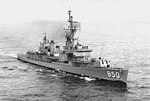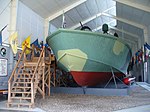USS Lionfish
1943 shipsBalao-class submarinesBuildings and structures in Fall River, MassachusettsCold War submarines of the United StatesMilitary and war museums in Massachusetts ... and 8 more
Museum ships in MassachusettsMuseums in Bristol County, MassachusettsNational Historic Landmarks in MassachusettsNational Register of Historic Places in Fall River, MassachusettsShips built by William Cramp & SonsShips on the National Register of Historic Places in MassachusettsTourist attractions in Fall River, MassachusettsWorld War II submarines of the United States

USS Lionfish (SS-298), a Balao-class submarine, was the only ship of the United States Navy named for the lionfish, a scorpaenid fish native to the Pacific and an invasive species found around the Caribbean. She was designated a National Historic Landmark in 1986, and is now on display at Battleship Cove in Fall River, Massachusetts.
Excerpt from the Wikipedia article USS Lionfish (License: CC BY-SA 3.0, Authors, Images).USS Lionfish
Water Street, Fall River
Geographical coordinates (GPS) Address External links Nearby Places Show on map
Geographical coordinates (GPS)
| Latitude | Longitude |
|---|---|
| N 41.706111111111 ° | E -71.163055555556 ° |
Address
USS Lionfish
Water Street 5
02721 Fall River
Massachusetts, United States
Open on Google Maps











